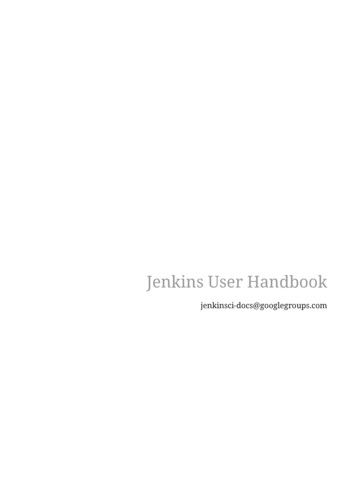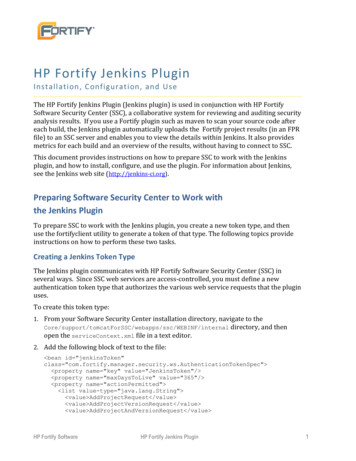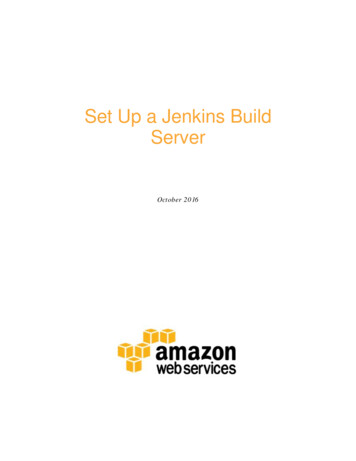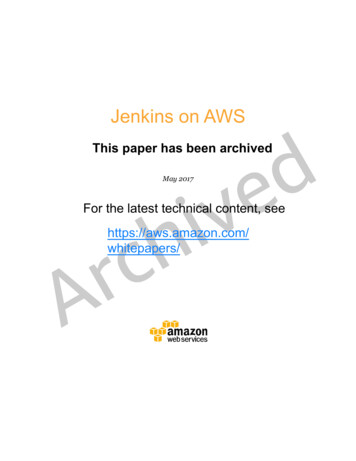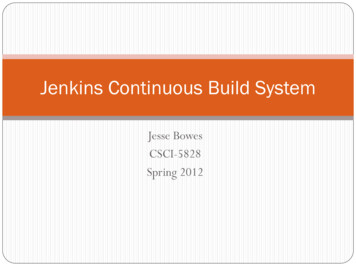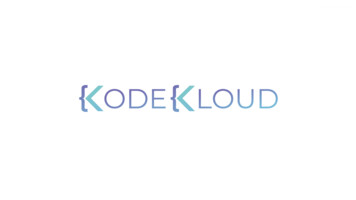
Transcription
What is JenkinsJenkins is one of the most popular automationtool used worldwide for continuous integrationand continuous delivery.Jenkins is a free and open-source automationserver that enables developers to build, integrate,and test code automatically as soon as it iscommitted to the source repository.
Why Jenkins?ChallengesWhen working on a project with different teams,developers often face issues with different teams usingdifferent CI tools, version management, and other tools.Setting up a CI/CD toolchain for each new project will leadto certain challenges like: Slower ReleasesManual BuildsNon-repeatable processesNo AutomationsSlower ReleasesManual BuildsNon-repeatableprocessesNo automations
Why Jenkins?SolutionJenkins is the solution to those challenges.It provides: Automated buildsAutomated buildsAutomated TestsAutomated CI/CD pipelinesAutomated deploymentsAbility to install Jenkins locallyJenkins support and PluginsCIAutomated TestsCDAutomated CI/CDpipelinesAbility to installJenkins locallyAutomateddeploymentsJenkins supportand Plugins
Why Jenkins?Open-source1000 pluginsFreePaid, Enterprise
Free!Jenkins is free and you don’t have to pay for anything.Jenkins can be hosted on a Virtual Machine, a container. Oreven locally for development purposes.
PluginsJenkins is well tested and provide several integrations with1800 plugins to support build, deployment and automationfor the project
Enterprise OptionsSupportManagedService
Continuous IntegrationContinuous Integration is a process in which the code ismerged from multiple contributors and added to a singlerepository.In simple words, CI is a process to take the code package itand send it to the CD for further processing.Continuous DeploymentContinuous Deployment is an automated process in which thecode is taken from the repository and deployed to the system.
Continuous Integration andContinuous Delivery/Deployment (CICD)CI/CD in simple words is a process to take a code, package it up anddeploy it to a system that can be serverless, a VM, or a container.CI/CD can be broken down into 3 steps: CI – Continuous Integration CD – Continuous Delivery CD – Continuous DeploymentCICDCD
The Key Pieces of CIKey Processes of Continuous Integration Package up the code Test the code (run unit tests, integration tests, etc) Run security checks against the code Unit testsIntegration testsTestsSecurity Checks
Continuous Integration (CI)Think of the Continuous Integration process like a gift you're wrapping The gift comes in piecesYou put the gift together (maybe a toy chest/box)The gift gets wrapped in wrapping paperYou put it in the car and deliver it to the person.
Continuous Integration (CI)
Continuous Deployment vsContinuous DeliveryThe basic difference between Continuous Delivery and ContinuousDeployment is that in Continuous Delivery to deploy the code after the CIprocess you have to manually trigger it via some button to deploy on thesystem whereas in Continuous Deployment this process is automatic.CDCDContinuous DeliveryContinuous DeploymentCICI
Key Pieces of CDKey Pieces of CD: Ensure you're authenticated to the system or wherever you're deploying Ensure that the code that's being deployed is working as expected once it's deployed AuthenticateCD processSystemCDTests
Installing JenkinsUbuntu nux/
Install Jenkins on UbuntuStep 1: Install Java on Ubuntu sudo apt update sudo apt sudo apt install openjdk-8-jdkAlternatively, install version 11: sudo apt install openjdk-11-jdkConfirm the download by pressing Y andEnterStep 2: Add the repository key to thesystem:Step 3: Once the key is added with noerrors, append the Debian packagerepository address sudo sh -c 'echo debhttp://pkg.jenkins.io/debian-stablebinary/ /etc/apt/sources.list.d/jenkins.list’Step 4: Run update to use new repository sudo apt updateStep 5: Install Jenkins sudo apt wget -q -O https://pkg.jenkins.io/debianstable/jenkins.io.key sudo apt-key add - sudo apt install jenkins
Start Jenkins on UbuntuAfter successful installation let us start Jenkins sudo systemctl start jenkinsThe above command will not display any outputTo check the running status of Jenkins use the below commandwhich should show active status on run sudo systemctl status jenkins
Jenkins PluginsPlugins are used in Jenkins to enhance Jenkins functionality and cater to user-specific needs.Just like how Gmail, Facebook and LinkedIn help you connect your one service to another,plugins also work the same way and allow us to connect one service to other services andwork with other products.Login with GoogleLogin with FacebookUserLogin with LinkedInWebsite
PluginsFor example, you want to connect to Azure from Jenkins you would need to download Azure Plugin whichwill allow you to connect to Azure at a programmatic level.Similarly, we can have other integrations with AWS, GitHub, etc using plugins.Azure PluginJenkinsAWS PluginGithub Actions Plugin
Install PluginsTo install a new plugin in Jenkins1) Go to Manage Jenkins - Manager Plugins2) Click Available and search for the desired plugin.3) Select the desired plugin and Install.Note: Few plugins may need a restartTo restart Jenkins sudo systemctl restart jenkinsOR
Update PluginsTo update any existing plugin in Jenkins1) Go to Manage Jenkins - Manager Plugins2) Click Updates and search for the desired plugin.3) Select the desired plugin and Install.Note: Few plugins may need a restartTo restart Jenkins sudo systemctl restart jenkinsOR
Delete PluginsTo delete any plugin in Jenkins1) Go to Manage Jenkins - Manager Plugins2) Go to Installed and search for the desired plugin.3) Click on uninstall button for the plugin you want to delete.Click yes to proceed with the deletion.
Jenkins VisualsVisualsJenkinsMenuBuildUseraccountNavigate
Jenkins JobsDifferent types of jobs that can be created in Jenkins:1) Freestyle projectThis is a central feature of Jenkins. It will build the project, combine SCM with the build system. It canalso be used for things other than building applications.2) PipelineThis is used to create a pipeline3) Multi-configuration projectThis is great if you need a large number of Jenkins configurations if you need multiple environmentslike Dev/ UAT.4) FolderThis creates containers and stores nested items. It is useful in grouping, creating a namespace, etc.5) Organisation folderCreates a multibranch project for all different subfolders that are available.6) Multibranch PipelineIt sets up pipeline projects for different repositories.
Administering JenkinsBackupRestoreScaleMonitorManage
Backup and RestoreFullBackupSnapshots
Which Files To Backup? JENKINS HOMEConfiguration files(config.xml)jobs
Backup JenkinsIt is crucial to have adequate backups of your Jenkins instance. Backups areused to recover from accidental configuration changes. Recovering a file thathas been mistakenly erased or has been corrupted. Or just to recover aprevious setup.There are two ways we can backup Jenkins:1) Using Plugins2) Using custom shell script
Backup JenkinsTo backup Jenkins using a plugin, you will first need to install a backup plugin.Some of the most commonly used plugins are ThinBackup, Periodic Backup,Google cloud Backup.For backing up using any of these plugins there are a few general steps thatmust be followed:1) Creating a backup directory with read and write access2) Selecting files that need backupBacking up using shell scriptPlease check out these popular repositories for your reference:1) repository: https://github.com/sue445/jenkins-backup-script2) gist: 4
JenkinsfileJenkinsfile is a text file that contains definitions. This could betemplates or instructions. It tells pipelines what they should bedoing and what services and plugins they should be interactingwith.Components of Jenkinsfile:1)2)3)4)Pipeline – The task you are trying to accomplishBuild Agent –The place where you run your pipelineStages – Staging/Production/UATSteps –Work done in the pipeline
What Is A Jenkinsfile?InstructionsTemplatesJenkinsfile
What Is A Jenkinsfile?InstructionsTemplatesJenkinsfile
Components of Jenkinsfile
StagingProdJenkinsfile
Multi-Stage nsfileDevStagingProdJenkinsfile
Build AgentsWindowsLinuxMacOSDocker
What Are Build Agents?CI Pipeline TestsBinaryArtifactBuild CodeRun testsUnit testIntegration testSmoke testPerformance testWindowsLinuxMacOS
Build AgentsBuild Agents are systems that run the processes throughout thepipelines.Build agents help in building codes, deploying, and runningautomated tests. It is a system that runs the entire workload.Task ExecutorBuild agentsRaspberry PiWindowsLinuxMacOSDocker
Running Builds on Same ServerJenkins ServerNot Recommended
Separate Build ServerJenkins ServerBuild ServerRecommended
Blue Ocean CICD
BlueOcean; New & Improved CICD!The whole idea of BlueOcean is a new UI experience for CICDin Jenkins Jenkins was definitely falling behind from a UI standpoint There were a ton of other CICD tools that felt much easierto use from a UI perspective BlueOcean is meant to changed that narrative
What Are We Getting Out OfBlueOcean? Sophisticated visualizations of continuous delivery (CD) Pipelines, allowing for fast andintuitive comprehension of your Pipeline’s status. Pipeline editor - makes the creation of Pipelines approachable by guiding the userthrough an intuitive and visual process to create a Pipeline. Personalization to suit the role-based needs of each member of the team. Pinpoint precision when intervention is needed and/or issues arise. Blue Ocean showswhere in the pipeline attention is needed, facilitating exception handling and increasingproductivity. Native integration for branch and pull requests, enables maximum developer productivitywhen collaborating on code with others in GitHub and Bitbucket.
Blue Ocean
Blue OceanEasier to useSophisticated visualizationsFast and intuitive Pipeline statusPipeline editorPersonalizationPinpoint precisionNative integration for branch and pull requests
Jenkins Security
Jenkins SecurityJenkins access control is split into two parts:1) Authentication (users prove who theyare) is done using a security realm. Thesecurity realm determines user identityand group memberships.2) Authorization (users are permitted to dosomething) is done by an authorizationstrategy. This controls whether a user(directly or through group memberships)has a permissionUser and access ControlAuthenticationSecurity RealmIdentityMembershipAuthorizationPermissions
Common Jenkins SecurityMistakesAnyone can do anythingThis authorization strategy is very rarely a good choice, as it allows even anonymous users to administer Jenkins. As a rule of thumb, itshould not be used. Never rely on the Jenkins URL to not be known outside your team or organization alone for security.Logged-in users can do anythingThis authorization strategy can be a sensible choice as long as only fully trusted users have accounts to access Jenkins. This is the defaultwith Jenkins’s single admin user when setting up Jenkins with the setup wizard.Switching to an authentication realm that allows untrusted users to have an account later will result in those users getting administrativeaccess to Jenkins if you keep this authorization stategy. Examples include enabling account signup for Jenkins' own user database, orvarious other authorization realms, many of which (GitHub, Google, GitLab, etc.) allow anyone to sign up for an account.Anonymous and authenticated usersSimilar to the previous items, you should generally not grant significant permissions to anonymous (the anonymous user) or authenticated(any authenticated user) when using an authorization strategy that allows finer-grained control (like Matrix Authorization Strategy).Granting Overall/Administer permission to anonymous is similar to Anyone can do anything, while granting that permissionto authenticated is essentially the same as Logged-in users can do anything.Built-in nodeUsers with limited permissions must not be able to configure jobs that run on the built-in node. When setting up a new Jenkins instance,adding users and switching authorization strategies, it is important to also set up distributed builds and limit what jobs are able to run onthe built-in node.ext
Jenkins SecurityCommon security mistakes that oftenhappens when using Jenkins Anyone can do anything Logged-in users can do anything Anonymous and authenticated users Built-in node
References1) ple2) https://github.com/AdminTurnedDevOps/Go-Demo-App
What is Jenkins Jenkins is one of the most popular automation tool used worldwide for continuous integration and continuous delivery. Jenkins is a free and open-source automation

